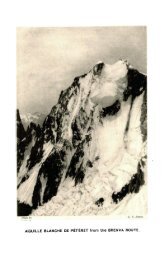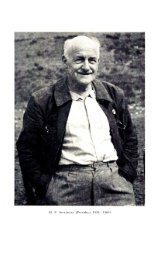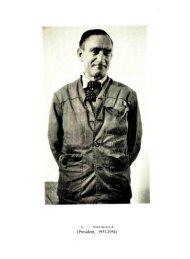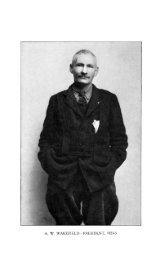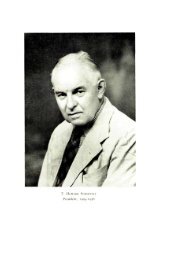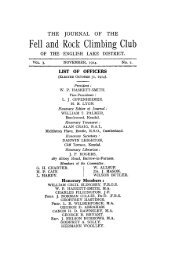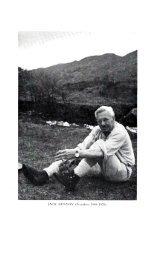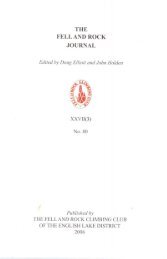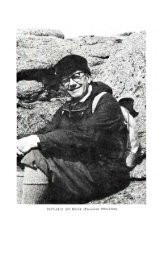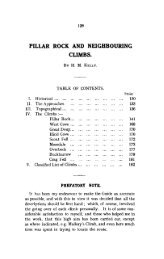Number in series 70; Year of publication 1986 - Fell and Rock ...
Number in series 70; Year of publication 1986 - Fell and Rock ...
Number in series 70; Year of publication 1986 - Fell and Rock ...
You also want an ePaper? Increase the reach of your titles
YUMPU automatically turns print PDFs into web optimized ePapers that Google loves.
40 A SHORT HISTORY OF LAKELAND CLIMBING - PART IIabove, other important routes also went unrecorded; The Crack, Joas <strong>and</strong>Asterisk on Gimmer, S<strong>in</strong>ister Slabs on Bowfell, Elim<strong>in</strong>ate 'A' on Dow, <strong>and</strong>many others. These omissions are quite <strong>in</strong>explicable, as some <strong>of</strong> them constituteimportant milestones <strong>in</strong> the development <strong>of</strong> the sport <strong>of</strong> rock climb<strong>in</strong>g <strong>in</strong> theLakes. The list ended <strong>in</strong> 1934 with two brilliant routes by that meteor <strong>of</strong> theclimb<strong>in</strong>g world, F.G.Balcombe; Buttonhook on Kern Knotts, which waspossibly the most technically hard climb at that time, <strong>and</strong> Eng<strong>in</strong>eer's Slab onGable Crag, an uncompromis<strong>in</strong>g steep face lack<strong>in</strong>g <strong>in</strong> belays, a route whichwent unrepeated for around twenty years. No mention was made <strong>of</strong> Balcombe'sequally important Direct F<strong>in</strong>ish to Central Buttress on Scafell however.Thus Kelly <strong>and</strong> Doughty left the history <strong>of</strong> Lakel<strong>and</strong> climb<strong>in</strong>g at a timewhen, to quote the prophetic words <strong>of</strong> C.F.Holl<strong>and</strong> <strong>in</strong> the 1936 Scafell guide,'the future is bright with the possibility <strong>of</strong> great developments, a time whenthere is no danger <strong>of</strong> the call <strong>of</strong> Ichabod, a time when we may feel that the best isyet to come'. Kelly <strong>and</strong> Doughty ended their masterly review with the hope that'if the <strong>Fell</strong> <strong>and</strong> <strong>Rock</strong> Club decides to celebrate the centenary <strong>of</strong> the first ascent <strong>of</strong>the Needle by another special number <strong>of</strong> the Journal, there seems no reason whythe historian chosen to record the do<strong>in</strong>gs <strong>of</strong> those <strong>in</strong>terven<strong>in</strong>g years should nothave at least as rich <strong>and</strong> varied a story to relate as that which we have tried totell'.The rate <strong>of</strong> exploration <strong>in</strong> the Lakes has <strong>in</strong>creased almost exponentially s<strong>in</strong>ce1934 with the result that whilst Kelly <strong>and</strong> Doughty could encompass the firstone hundred <strong>and</strong> fifty years <strong>of</strong> climb<strong>in</strong>g <strong>in</strong> a relatively short review, justice canonly be done to the follow<strong>in</strong>g half-century by splitt<strong>in</strong>g the history <strong>in</strong>to threesections.The 1930's: The Great Aid Debate Commences.By the end <strong>of</strong> 1934, the foundations <strong>of</strong> modern rock climb<strong>in</strong>g had alreadybeen laid. The hard-won technique <strong>of</strong> the gritstone-tra<strong>in</strong>ed climbers Botterill,Herford, Kelly, Frankl<strong>and</strong>, Piggott, L<strong>in</strong>nell <strong>and</strong> A.T.Hargreaves had resulted<strong>in</strong> a great advance <strong>in</strong> st<strong>and</strong>ards, <strong>and</strong> the renaissance <strong>of</strong> Welsh climb<strong>in</strong>g,particularly the early development <strong>of</strong> Clogwyn du'r Arddu, had a pronouncedeffect on Lakel<strong>and</strong> climb<strong>in</strong>g by encourag<strong>in</strong>g the exploration <strong>of</strong> crags which hadpreviously been declared unclimbable. The open<strong>in</strong>g up <strong>of</strong> the East Buttress <strong>of</strong>Scafell was a direct result. The use <strong>of</strong> a piton to accomplish a difficult ascent(Overhang<strong>in</strong>g Wall on Scafell, 1933), an event which was regarded withdisfavour by many climbers at that time, triggered-<strong>of</strong>f a debate on the use <strong>of</strong> aidwhich has cont<strong>in</strong>ued unabated ever s<strong>in</strong>ce. That superb climber Maurice L<strong>in</strong>nellmust have had reservations about plant<strong>in</strong>g the piton when he threw out achallenge <strong>in</strong> the Rucksack Club Journal <strong>of</strong> 1934: 'those who prefer to climb theplace unaided are cordially <strong>in</strong>vited to remove the piton <strong>and</strong> do so'. Generations<strong>of</strong> climbers did not appear to have either the <strong>in</strong>cl<strong>in</strong>ation or ability to take up thisJ<strong>in</strong>



